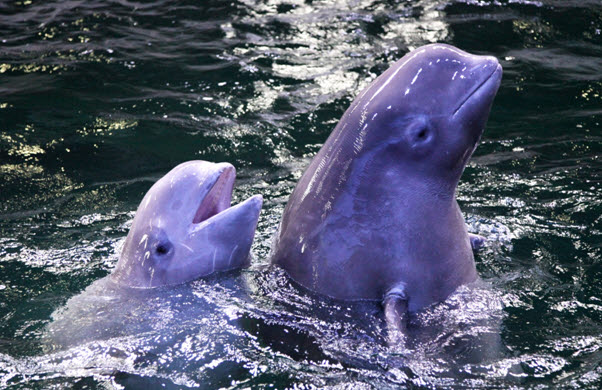“Lu-O”, “Lu-V” and “Lu-E”, Not Just For Exhibition
- Date
- 2012.07.17 09:31
- Views
- 1315
- Registrar
- 관리자
“Lu-O”, “Lu-V” and “Lu-E”, Not Just For Exhibition
Three Belugas Rise to Fame … Joint Ecology Research with Ulsan Whale Research Institute is Underway
Lu-O, Lu-V and Lu-E, the three adorable belugas at Aquarium, are earning huge popularity. Visitors would gladly spend two hours waiting for a chance to meet them.
The Organizing Committee for Expo 2012 Yeosu Korea unveiled the story behind the belugas on 13th.
□ New names for the three belugas
Lu-O, Lu-V and Lu-E, the names given to the three belugas, were selected through a naming contest. Each of their names starts with “Lu” for “Beluga”, and finishes with the alphabets O, V, E, respectively, which stand for “LOVE” when combined with “L.” Just like the names say, Lu-O (aged three), Lu-V (aged two) and Lu-E (aged 1) have become the most-loved marine life at Yeosu Expo.
□ Belugas are not dolphins but white whales
Belugas are often mistaken as dolphins. In fact, they have white body that grows to be about 4 meters on overage, and far bigger than dolphins. They are also smarter than dolphins, sociable and have a lovely look. The playful belugas, who can perform a trick of blowing bubble rings, are one of the most popular marine lives around the globe.
□ What do belugas eat?
The Beluga’s diet mainly consists of atka mackerel, the skin of which is used in making rice balls in Korea, and savory herring. Belugas are provided with the freshest fish possible that can be rightly consumed by humans, and the rest of the stock are discarded even with the slightest scar.
Belugas consume a whopping amount of 5 kilograms of fish a meal, three times a day, and the total diet amounts to 500 kilograms a month. Vitamins are added to the three whale’s food for a healthier diet as well. The belugas, aged one to three, have all become stronger and whiter than when they first arrived at the Aquarium (Belugas turn from grey to white at around the age of five) under great care from the aquarists.
□ The belugas are not just for exhibition!
The belugas, despite being popular visitor attractions, do not perform an entertainment show at the Expo. This is due to an agreement with Russia that the whales are for preservation of the species and research purposes. Currently, various researches are underway regarding their ecological characteristics by the Ulsan Whale Research Institute and the aquarists at the Aquarium, and it is expected that this would serve as a great opportunity to develop an unknown part of the marine life.
Three Belugas Rise to Fame … Joint Ecology Research with Ulsan Whale Research Institute is Underway
Lu-O, Lu-V and Lu-E, the three adorable belugas at Aquarium, are earning huge popularity. Visitors would gladly spend two hours waiting for a chance to meet them.
The Organizing Committee for Expo 2012 Yeosu Korea unveiled the story behind the belugas on 13th.
□ New names for the three belugas
Lu-O, Lu-V and Lu-E, the names given to the three belugas, were selected through a naming contest. Each of their names starts with “Lu” for “Beluga”, and finishes with the alphabets O, V, E, respectively, which stand for “LOVE” when combined with “L.” Just like the names say, Lu-O (aged three), Lu-V (aged two) and Lu-E (aged 1) have become the most-loved marine life at Yeosu Expo.
□ Belugas are not dolphins but white whales
Belugas are often mistaken as dolphins. In fact, they have white body that grows to be about 4 meters on overage, and far bigger than dolphins. They are also smarter than dolphins, sociable and have a lovely look. The playful belugas, who can perform a trick of blowing bubble rings, are one of the most popular marine lives around the globe.
□ What do belugas eat?
The Beluga’s diet mainly consists of atka mackerel, the skin of which is used in making rice balls in Korea, and savory herring. Belugas are provided with the freshest fish possible that can be rightly consumed by humans, and the rest of the stock are discarded even with the slightest scar.
Belugas consume a whopping amount of 5 kilograms of fish a meal, three times a day, and the total diet amounts to 500 kilograms a month. Vitamins are added to the three whale’s food for a healthier diet as well. The belugas, aged one to three, have all become stronger and whiter than when they first arrived at the Aquarium (Belugas turn from grey to white at around the age of five) under great care from the aquarists.
□ The belugas are not just for exhibition!
The belugas, despite being popular visitor attractions, do not perform an entertainment show at the Expo. This is due to an agreement with Russia that the whales are for preservation of the species and research purposes. Currently, various researches are underway regarding their ecological characteristics by the Ulsan Whale Research Institute and the aquarists at the Aquarium, and it is expected that this would serve as a great opportunity to develop an unknown part of the marine life.


